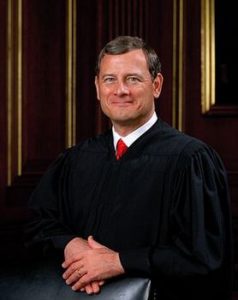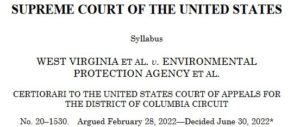
CFact June 30, 2022
A victory for those who care about sound science, reliable energy and limited government.
Click here to read the full decision:
Supreme Court — West Virginia vs EPA
 Chief Justice Roberts authored the opinion of the Court, joined by Justices Thomas, Alito, Gorsuch, Kavanaugh and Barrett.
Chief Justice Roberts authored the opinion of the Court, joined by Justices Thomas, Alito, Gorsuch, Kavanaugh and Barrett.
Justice Elena Kagan authored a dissent, joined by Justices Breyer and Sotomayor.
Excerpts:
“Congress did not grant EPA in Section 111(d) of the Clean Air Act the authority to devise emissions caps based on the generation shifting approach the Agency took in the Clean Power Plan.”
“The only question before the Court…” Whether the “best system of emission reduction” identified by EPA in the Clean Power Plan was within the authority granted to the Agency in Section 111(d) of the Clean Air Act. For the reasons given, the answer is no.”
“The Agency determined that “the interpretative question raised” by the Clean Power Plan—“i.e., whether a ‘system of emission reduction’ can consist of generation-shifting measures”—fell under the “major question doctrine.” Under that doctrine, EPA explained, courts “expect Congress to speak clearly if it wishes to assign to an agency.”
“Where the statute at issue is one that confers authority upon an administrative agency, that inquiry must be “shaped, at least in some measure, by the nature of the question presented”—whether Congress in fact meant to confer the power the agency has asserted.”
“In the words of the then-EPA Administrator, the rule was “not about pollution control” so much as it was “an investment opportunity” for States, especially “investments in renewables and clean energy.” This view of EPA’s authority was not only unprecedented; it also effected a “fundamental revision of the statute, changing it from [one sort of] scheme of . . . regulation” into an entirely different kind. MCI, 512 U. S., at 231. Under the Agency’s prior view of Section 111, its role was limited to ensuring the efficient pollution performance of each individual regulated source. Under that paradigm, if a source was already operating at that level, there was nothing more for EPA to do. Under its newly “discover[ed]” authority, Utility Air, 573 U. S., at 324, however, EPA can demand much greater reductions in emissions based on a very different kind of policy judgment: that it would be “best” if coal made up a much smaller share of national electricity generation. And on this view of EPA’s authority, it could go further, perhaps forcing coal plants to “shift” away virtually all of their generation—i.e., to cease making power altogether.”
“We also find it “highly unlikely that Congress would leave” to “agency discretion” the decision of how much coal-based generation there should be over the coming decades.”
“We cannot ignore that the regulatory writ EPA newly uncovered conveniently enabled it to enact a program that, long after the dangers posed by greenhouse gas emissions “had become well known, Congress considered and rejected” multiple times… Congress has consistently rejected proposals to amend the Clean Air Act to create such a program.”
“Our precedent counsels skepticism toward EPA’s claim that Section 111 empowers it to devise carbon emissions caps based on a generation shifting approach. To overcome that skepticism, the Government must—under the major questions doctrine—point to “clear congressional authorization” to regulate in that manner.”
“Just because a cap-and-trade “system” can be used to reduce emissions does not mean that it is the kind of “system of emission reduction” referred to in Section 111. Indeed, the Government’s examples demonstrate why it is not.”
“It is not plausible that Congress gave EPA the authority to adopt on its own such a regulatory scheme in Section 111(d). A decision of such magnitude and consequence rests with Congress itself, or an agency acting pursuant to a clear delegation from that representative body.”
_____
From CFACT:
The message is clear. Regulatory agencies must operate within the authority granted them by law. They must not exceed that authority.
This is fundamental.




